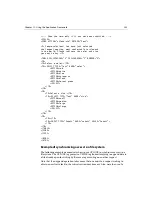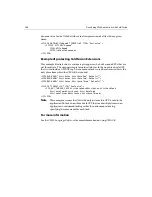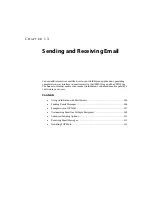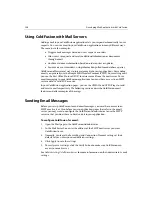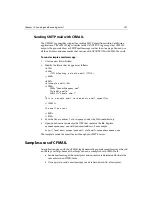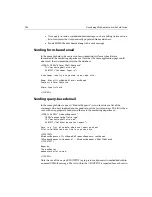
Chapter 12: Using the Application Framework
193
Variable caching
All client variable reads and writes are cached to help decrease the overhead of client
state management operations. See Administering ColdFusion Server for information
on variables and server clustering.
Exporting the client variable database
If your client variable database is stored in the system registry and you need to move it
to another machine, you can export the registry key that stores your client variables
and take it to your new server. The system registry allows you to export and import
registry entries.
To export your client variable database from the registry:
1.
Open the registry editor. In UNIX, use the program,
/<install_dir>/
coldfusion/bin/regedit.
2.
Find and select the following key:
HKEY_LOCAL_MACHINE\SOFTWARE\Allaire\ColdFusion\
CurrentVersion\Clients
3.
On the Registry menu, click Export Registry File.
4.
Enter a name for the registry file.
Once you’ve created a registry file, you can take it to a new machine and import it by
selecting Import Registry File on the Registry Editor Registry menu.
Application and Session Variables
In ColdFusion, you use variables to work around the Web’s inherent statelessness.
Session and application variables are persistent variable "scopes." You access these
variables by prefacing the variable name with the scope name, for example:
Session.MyVariable or Application.MyVariable. And because they are persistent, you
can pass values between pages with a minimum of effort.
Enabling application and session variables
Session and application variables are similar in operation to client variables. Like
client variables, they are enabled with the CFAPPLICATION tag. However, unlike client
variables, which are stored in the system registry, a data source, or a cookie,
application and session variables are always stored in the ColdFusion server’s
memory. This method offers obvious performance advantages. In addition, you can set
time-out values for these variables either with CFAPPLICATION, or by specifying time-
outs in the ColdFusion Administrator. You can also simply disable application and
session variables entirely.
Summary of Contents for COLDFUSION 4.5-DEVELOPING WEB
Page 1: ...Allaire Corporation Developing Web Applications with ColdFusion ColdFusion 4 5...
Page 14: ...xiv Developing Web Applications with ColdFusion...
Page 26: ...xxvi Developing Web Applications with ColdFusion...
Page 34: ...8 Developing Web Applications with ColdFusion...
Page 70: ...44 Developing Web Applications with ColdFusion...
Page 84: ...58 Developing Web Applications with ColdFusion...
Page 114: ...88 Developing Web Applications with ColdFusion...
Page 148: ...122 Developing Web Applications with ColdFusion...
Page 174: ...148 Developing Web Applications with ColdFusion...
Page 208: ...182 Developing Web Applications with ColdFusion...
Page 244: ...218 Developing Web Applications with ColdFusion...
Page 274: ...248 Developing Web Applications with ColdFusion...
Page 288: ...262 Developing Web Applications with ColdFusion...
Page 300: ...274 Developing Web Applications with ColdFusion...
Page 350: ...324 Developing Web Applications with ColdFusion...
Page 362: ...336 Developing Web Applications with ColdFusion...

























